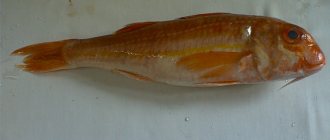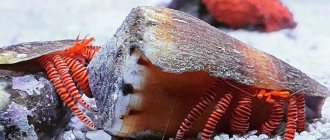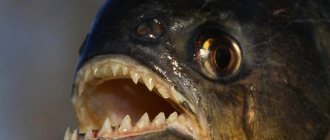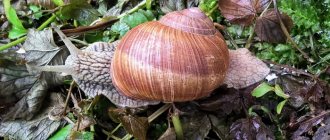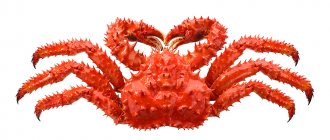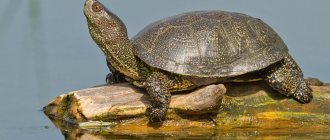- Wild animals
- >>
- Crustaceans
Kamchatka crab is also called King crab due to its impressive size. The benthic marine life is interesting as a biological species; it is also of interest from an economic point of view, since it is an object for commercial fishing. The habitat is wide. The Kamchatka crab is one of the few zoo representatives that has successfully undergone the process of artificial relocation.
marble crab
The crustacean inhabitant Pachygrapsus marmoratu with a trapezoidal shell has acquired many names from the local population of Crimea and the Black Sea coast. For walking on land in search of food, the crab was nicknamed the gypsy. For the timidity of the inhabitant, running away at breakneck speed at the first danger, the long hairy legs are called a sea spider.
The motley shell with a moire pattern (a combination of blue-green, brownish spots with light spots), similar to noble marble, attracts tourists and artisans for making souvenirs. The size of the sea spider is small, only 3-5 cm wide.
It inhabits rocky bottom areas at a depth of up to 10 m, often comes ashore for food, and can remain without water for a long time. The only species that on land climbs to heights of up to 2 - 3 m.
The Black Sea marble crab knows how to hide in cracks and hide behind a stone using a pair of walking legs. It has no gastronomic value. It is listed as a rare species in the Red Book.
Marble crab can go without water for a long time
Habitats
Crabs have adapted to living in various conditions. They are found in all seas, oceans, in different climate zones, in water of different salinity and temperature. Many crustaceans live in the seas, but there are types that live in freshwater bodies. They were accidentally introduced to Europe and are found in the river basins of Switzerland, Sweden, Germany and France.
You can even find species that live on land, for example, the palm thief. Its larvae are found in the sea, while adults live on land. Reproduction only occurs in water.
freepik
Stone crab
The deep sea dweller Eriphia verrucosa Forskall loves its own areas, which it protects from its relatives. At night it gets out into shallow water, coastal stones. Compared to other species, the mason is considered a giant. The length of the shell is 9–10 cm, and the record holder was a crab of 15 cm.
The complex red-brown color is interspersed with brown-olive shades. It is almost impossible to see the crab at the bottom, it merges so much with the muddy mass. Lumps, growths, prickly hairs, and thorns enhance camouflage and serve as protection. The crab is unusually strong. With powerful claws it lifts stones that are 30 times their weight.
The Black Sea stone crab at depths of up to 30 m feeds on mollusks, invertebrate small things, carrion, and sometimes eats wounded relatives. A clever hunter collects snails and catches small fish. The omnivorous inhabitant is of interest to gourmets for its tasty meat, rich in vitamins and microelements, and to handicraftsmen for its large shell for souvenirs.
The local population catches masons at night when they are available in shallow waters. Blinded by bright lights, crabs become easy prey. Uncontrolled fishing reduces the number of inhabitants recognized as an endangered species.
The color of the stone crab perfectly camouflages it on the sandy bottom
Features of character and lifestyle
Photo: Kamchatka crab
The strong frame of the arthropod, serving as protection and support, at the same time prevents growth between the moments of its change. The animal grows only in a short period (usually no more than 3 days), when the old hard frame is discarded, and the new one, still soft and pliable, does not interfere with its rapid increase in size. After a growth spurt, the chitinous cover is intensively impregnated with calcium salts and overall growth stops until the subsequent molt.
The frequency of shell changes varies over the course of life:
- up to 12 times after the formation of the larva during the year;
- up to 7 times, less often in the second year of life;
- 2 times during the year during the period of life from the third to the ninth year of an individual’s life;
- 1 time from the ninth to the twelfth years of life;
- Once every two years, from the age of thirteen until the end of your life.
During molting, the animal tries to find shelter in depressions or rock cracks, as it becomes defenseless without a strong frame.
Interesting fact. Molting affects not only the outer cover of the crab; internal organs are also renewed - the membranes of the esophagus, stomach and intestines are renewed. The ligaments and tendons with which muscle fibers are attached to the exoskeleton are also subject to renewal. Cardiac tissues are also renewed.
A representative of this species is a rather active arthropod, constantly performing migratory movements. The route of movement does not change, repeating itself every year. The reason for migration is seasonal changes in water temperature and the availability of food, as well as the reproductive instinct.
So, with the onset of winter, the crab sinks along the bottom into deep waters within 200-270 m. With warming, it returns to the warm shallow waters filled with food. Crabs migrate en masse, gathering in groups of varying numbers. Males are ready to breed when they reach ten years of age and females are seven or eight years old.
Herbal crab
A lover of lagoons, estuaries with abundant algae, in which he usually hides from enemies or for hunting. The triangular shell of a greenish tint is 7-8 cm wide. The claws are short, strong, and can break the finger of a careless catcher. It moves very quickly, reaching speeds of up to 1 m/sec.
Appears on sea beaches, when in danger, buries itself in the sand and runs into the water. It dives into the sea to depths of up to 40 m. It feeds, like other species of Black Sea crabs, on dead organic matter, algae, small bottom organisms, and does not disdain its relatives.
On the coast, crushed shellfish, jellyfish washed up on the sand are a favorite delicacy of herbal crabs. It has been noted that Carcinus aestuarii Nordo is sensitive to the level of salt in the water.
The saltier it is, the more comfortable it is for the inhabitant. Another name for the crustacean is the Mediterranean crab. Previously it was considered a commercial species, but now with the status of “rare” it is also included in the Red Book.
Herbal crab is in the Red Book
Social structure and reproduction
Photo: Sea Kamchatka crab
After the onset of spring, males begin their journey to shallow water. Females move in the same direction, but in separate groups. The female carries already ripe eggs on legs located near the abdomen. Closer to shallow water, larvae emerge from the eggs and are carried away by the current. By this time, new eggs have already been formed in the female’s genital organs, which are yet to be fertilized.
With the beginning of molting, individuals of both sexes come closer and form a characteristic pose - the male holds the female with both claws, reminiscent of shaking hands. The holding continues until the end of the moult; sometimes the male helps the chosen one to free herself from the old frame. After the completion of molting (on average from three to seven days), the male releases a ribbon with germ cells - spermatophores, which is attached to the female’s legs. The male, having completed the mission, leaves and also molts.
After some time (from several hours to several days), the female spawns eggs (from 50 to 500 thousand), which, when they meet the male’s ribbon, are fertilized. A special sticky substance collects the eggs together and attaches them to the villi on the female's abdominal legs, where they undergo a development cycle until the following spring, for 11 months. The female spawns eggs only once a year, in the spring, but males can mate with several females.
The larvae that have just hatched from the eggs remain in the water column for about two months and are transported by the current; at this stage of development, up to 96% of the larvae die. Afterwards, the surviving larvae sink to the bottom, into algae thickets, where they live for three years. They molt frequently and go through several stages of development. Then the young individuals move to sandy bottom areas. Migration begins after reaching 5 years of age, sometimes 7 years of age.
Swimming crab
It is impossible to confuse the swimming crab with its relatives due to its characteristic feature - wide legs transformed in appearance into flippers. The inhabitant of Portunidae has a clear advantage over other species.
The ability to swim well, quickly burrow, throwing sand at itself, does not make the crab an easy prey. Amazing eyes are planted as if on stalks that can extend and retract.
The swimmer is active at night and hides in the sand during the day. The color of the shell in gray-beige tones with a green tint contributes to ideal camouflage. The size of the underwater resident is only 3-4 cm. The sandstone is not liked by fishermen, who gave it the nickname “barber” for its brilliant ability to cut nets to not only release itself, but the entire catch.
The back claws of the swimming crab look a bit like oars.
Application
Crab meat is a very valuable food product. The live weight of meat occupies about 42% of the total body weight. About one and a half billion tons of crabs are caught and grown in the world every year. Raw meat is gray in color and has a jelly-like consistency. It is not eaten raw. It must first be thermally treated.
The composition contains essential amino acids and glycogen, thanks to which the meat has a pleasant sweetish taste. The meat also contains biologically active phosphorus, sulfur, and magnesium. The limbs and abdomen of the crab are eaten. There is a red film under the shell. When molting begins, this film is transformed into a new shell.
Crab meat brings great benefits to the body for various disorders in the hematopoietic system. It is recommended to use it to improve the quality of vision. This is a good prevention of heart and vascular diseases. The calorie content of meat is low, 100 g of product contains no more than 72 kcal, proteins - 18 g, fats - 0.5 g, and no carbohydrates. This is a low-calorie product that is recommended to be included in the diet menu.
Despite the benefits of seafood, it can be harmful to health. Its diet includes not only live food, but also carrion. Animal remains may contain parasites and infections. Eating contaminated meat is fraught with various complications - deterioration in the quality of vision, poisoning, disturbances in the functioning of the central nervous system. Those who suffer from allergic reactions to seafood are prohibited from eating meat.
freepik
Blue crab
A rare species of Callinectes sapidu due to unsuitable climatic conditions for increasing the population. The name is directly related to a special pigment, thanks to which the claws and ends of the paws are blue-turquoise, which also glow in the water. The characteristic color distinguishes only males; females are decorated with red claws.
The swimming crab was brought with sea ships from the warm waters of the Mediterranean Sea, and there the immigrant took root as a result of traveling from the coasts of the United States. For comfortable life, the inhabitant needs a temperature of 15–30°C; in the Black Sea waters, the crab has to “harden” at 7–20°C.
Blue crabs of the Black Sea in the photo , but the inhabitants can be difficult to find at depths of up to 30 m, most often in shallow rivers. The edges of the wide carapace, 10-20 cm, are covered with sharp spines.
The crab is quite aggressive compared to its relatives. In danger, the inhabitant is able to drop the claws and later restore them. The rear flat paws in the form of flippers help to swim perfectly in the water column.
Among crabs, blue is the most aggressive
Appearance and features
Photo: Live Kamchatka crab
The crab's body consists of two parts - the cephalothorax, located under a protective shell, and the abdomen, folded under the cephalothorax. The eyes are protected by an overhanging shell or beak. The carpax has sharp protective spine-like spines, 6 of which are located above the heart and 11 above the stomach area.
In addition to the protective function, the shell also serves as a support and exoskeleton, because muscle fibers that carry out movements are attached to it from the inside. On the lateral surfaces of the frame shell there are respiratory organs - gills. The nervous system is represented by a chain of interconnected nerve nodes located on the underside of the cephalothorax and abdomen. The heart is located at the back, and the stomach is located at the head.
Of the five pairs of legs, the crab uses only four to move. The reduced fifth pair is hidden under the shell and is used to clean the gills.
Interesting fact. The use of claws in the Kamchatka crab differs in the nature of the function performed. With its left claw, the crab cuts softer food, and with its right claw it crushes hard food - sea urchins that live on the bottom, the shells of various mollusks. The claws differ in size; the right one is larger, performing more difficult work.
In males, the width of the body varies from 16 to 25 cm and the weight reaches 7 kg. The distance between the ends of the long legs of the largest individuals is about 1.5 m. Females are smaller in size - body up to 16 cm, weight on average 4 kg. The female is also distinguished by the presence of a round and irregularly shaped abdomen.
The color of the shell of the Kamchatka crab is red with a brown tint on top, areas and inclusions in the form of purple specks are noted on the side surfaces, the color of the crab is lighter below - from white to yellowish.
Hairy crab
The unusual inhabitant Pilumnus hirtellus is quite often encountered by divers off the coast of Crimea, in areas of rocks, rocky deposits, overgrown with algae. The name “hairworm” was given for the dense bristly cover on the reddish-purple shell measuring 22-28 mm.
It is interesting that the crab does not run away when meeting a person, but takes a fighting position, sticking out its claws. The organism of the sea dweller can withstand storms and low temperatures. You can see the crab in natural conditions at a depth of 10-35 m. The population is declining for a number of reasons, including illegal crab fishing in the Black Sea .
Hairy crab or "hairy crab"
Lilac crab, or water lover
It is difficult to find a colored inhabitant, since it is reliably camouflaged among stones and vegetation and does not go onto land, which is why it received the name “water lover.” The inhabitant of Xantho poressa Olivi is so quiet that it can cover itself with sea pebble and hide for several days.
The size of an adult crab is approximately 6 cm. Strong claws, disproportionately large, are strong enough to turn over stones. The legs are small and weak, and the lilac crab cannot move with acceleration like other relatives.
The shades of the shell and claws are not only lilac, but also purple and greenish. It feeds on the same thing that other varieties of Black Sea crabs eat - carcasses of dead bottom inhabitants, aquatic vegetation.
sand crab
The most leisurely inhabitant of Xantho poressa in comparison with other relatives of the Black Sea. At the moment of danger, it does not run away, but freezes, imitating a small pebble at the bottom. The shell size is 5 – 6 cm. The reddish-orange color contributes to good camouflage.
If the crab is nevertheless disturbed, the inhabitant will begin to click its claws in a threatening pose. When losing its weapon in the fight against an enemy, the crab is able to grow new claws.
Loves rocky surfaces, where it is easier to hide. Due to the sluggishness of the sand crab, the population is decreasing; the inhabitant is easy prey for humans and natural enemies.
Sand crab is the smallest
Rock crab
The self-explanatory name suggests where crustacean representatives are most often found. Grapsus grapsus crabs have the unique ability to cling to the surface of rocks with such force that even a powerful wave cannot tear the creature off.
The length of the chitinous shell is almost square in shape, 6–8 cm. It is distinguished by the ability to run quickly in any danger. The direction of running is changed so often that they make the task of the pursuer many times more difficult, which is how they escape. The red color of the crab indicates its aggressiveness towards competitors and enemies. They feed on algae on rocky surfaces, dead fish, and dead birds.
Dutch crab
A unique crab that can adapt to salty and fresh water. Its modest size, no more than 3 cm, does not hinder the culinary interest shown by seafood connoisseurs. The meat of the animal is soft and juicy. The color of the crab is dark brown or terracotta in color. The surface of the shell has convex tubercles.
The Dutch crab is most often in active movement, searching for food. The creature Rhithropanopeus Harrisii, unpretentious in its diet, picks up everything that can be eaten - the remains of the feasts of its relatives, algae, any organic matter.
Dutch crab can be kept in a home aquarium
Sea hermit crab
The crustacean resident is not similar to its relatives in appearance and habitat features. The abdomen forms a sea shell in which the hermit crab is safely hidden. The Black Sea is rich in varieties of such organisms, living in communities of up to hundreds of individuals. During the stages of growth and development, Paguroidea exchanges a tight shell for a new one, which it captures from dying snails.
Brown crab
An endangered species, crab fishing is prohibited. Large carapace of a brownish-burgundy hue, approximately 10 cm long. The claws are of more saturated tones. During the day it is passive, hiding among reefs. At night it searches for prey among small crustacean inhabitants, mollusks, and does not refuse organic carrion.
№14
The boxer crab is one of the most unique species. It is nocturnal and hides in a shelter during the daylight hours, closing its passage with its claws. And not a single sea creature comes near his shelter. Why are they afraid of his claws? The whole point is that he “plants” sea anemones and polyps on his claws, which sting very painfully. Marine inhabitants know this. The crab uses sea anemone for its protection. When someone threatens him, he assumes a boxing pose and starts swinging his “gloves.”
Sea anemones also benefit from such an alliance. They lead a sedentary lifestyle, and the crab serves as transport for them. In addition, they feast on the leftover food left after the “boxer” hunts.
We also recommend reading: Interesting facts about Scorpios
Phalanx crab
In addition to large, medium-sized individuals, there are small Black Sea crabs that look like spiders. In most cases, these representatives of the families are interesting as scientific objects of fauna. Many live at depth; it is problematic for divers to catch them as prey.
The crab phalanx does not exceed 30 mm when measured together with the legs. The inconspicuous inhabitant Macropodia longirostris hides among stones and bottom vegetation in the coastal zone at a depth of up to 20 meters.
The brownish color helps with camouflage. Many call the animal invisible for its ability to hide. It is no coincidence that the marine life was discovered and described relatively recently, in 1975.
Long-legged crabs
The small body and very long legs convey the resemblance of crabs to spiders. Similar creatures of both modest and gigantic dimensions live.
Deep Giant
An unusual aquatic inhabitant of large size: length, including legs, about 6 meters, weight up to 20 kg. Residents of deep areas up to 300 meters hide in thickets of algae and practically never leave their shelters. Only in spring, for reproduction, the long-legged crab moves to the upper layers, up to 50 meters.
It is extremely difficult to guess that a living creature is hiding among underwater plants. The color completely matches the habitat, and the long legs, covered with algae, are hardly noticeable. Only the movement of the shell reveals the long-legged crab.
The diet does not differ from the diet of smaller relatives - shellfish, carrion, algae. The giant lives for almost a hundred years. In cooking, crab is served as a great delicacy, but more often the unusual inhabitant is placed in large aquariums as decoration. The object remains of scientific interest; scientists continue to study the unusual creature.
Small varieties
Studying the smallest inhabitants gives an idea of which crabs in the Black Sea ensure the cleanliness of the reservoir and help maintain the ecological balance. The species Macropodia rostrata is found at depths of up to 20 meters.
It is distinguished by a triangular shell, the size of which is only 29 mm, and disproportionately long legs. Females are even smaller, with a tiny body 16 mm long. On land, the creature resembles a fragment of an aquatic plant.
In their natural environment, the movements of active crabs are similar to riding a bicycle. You should not hunt crustacean inhabitants for fun. Specimens that are not recognized as rare or endangered are allowed to be used in cooking.
Structure
The crab seen in the photo differs from the crayfish in its structure and the way it looks. One of the significant differences is the structure of the abdomen - it is small in size and tucked under the chest. The crustacean crabs seen in the photo have 5 pairs of limbs. Of these, a pair of claws is designed to capture prey, the other 4 pairs of limbs are needed for the movement of representatives of the Crustacean family, class Higher crustaceans.
All types of crabs are found in bodies of water; respiration occurs thanks to gills. An interesting feature of the crab family is that they are not able to inhale the surrounding air while on land. They breathe the air that has accumulated in their gills.
The shell of an arthropod is its skeleton, which is located outside. It provides a protective function and also serves as support.
Interesting. During fights with enemies, this sea animal can lose its claw, as a result it gradually grows back. This explains that the size of one claw is larger than the size of the second.
The body is protected by a chitinous shell and extends into the cephalothorax. The eye sockets are located on stalk-like processes, the structure is complex, faceted, that is, inside there are a large number of eyes that send information to the brain cells. Many species of arthropods have a flat abdomen and flattened body, thanks to which they can safely hide from predators at the bottom under stones and rocky surfaces.
When molting begins, animals shed their shells and remain defenseless for a certain period. In order to protect themselves, they hide in crevices, empty shells, and holes. Adult males show aggression towards members of their own sex, this is especially evident when the breeding season begins.
The chitinous shell reliably protects marine life. But they still become prey for octopuses, sea otters, and some varieties of large fish. Fishing for crabs by people threatens their population; many of their species are included in the Red Book. To protect itself from predators, the crab animal uses camouflage. When he senses danger, his shell becomes the same color as his habitat - sand, stone. Movement occurs sideways, with the claws pointed forward.
freepik
